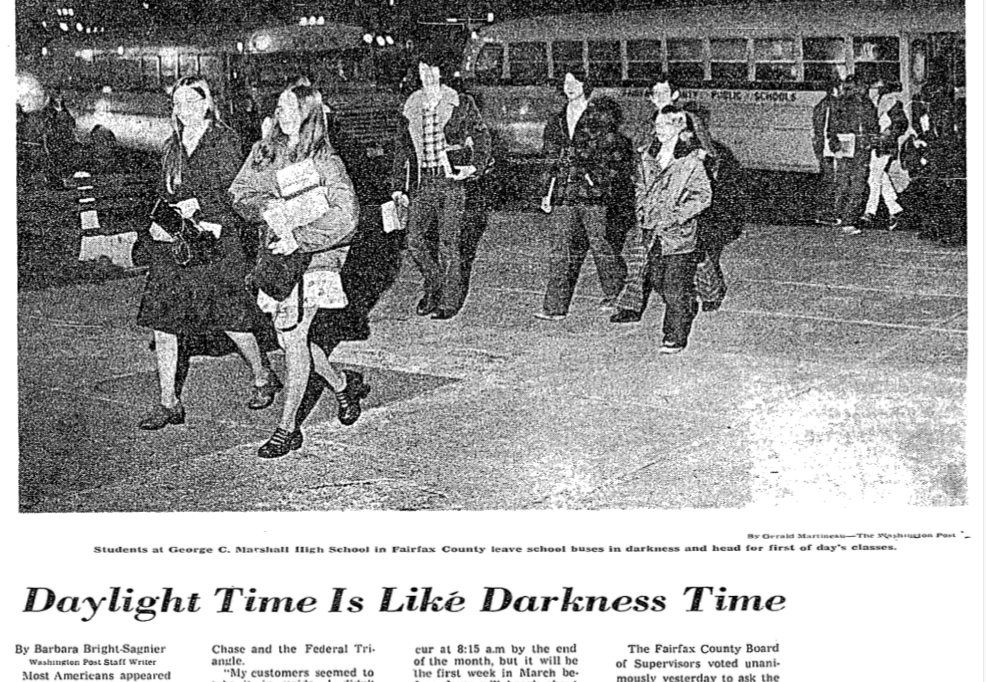The sun rose at 8:27 AM on January 7, 1974. Children in the Washington area had left for school in the dark that morning, thanks to a new national experiment during a wrenching energy crisis: most of the US went to year-round daylight saving time beginning on January 6. “It was jet black” outside when her daughter was supposed to leave for school, Florence Bauer of Springfield told the Washington Post. “Some of the children took flashlights with them.”
The change would benefit Americans in the long run, predicted Steve Grossman of the Department of Transportation. Yes, accidents in the morning darkness may become more common, he said, but longer daylight hours could mean eliminating the hazards of evening commutes: “stress, anxiety, and many drivers have had a couple of drinks,” as he told the Post. Outside the capital, others vowed defiance: Robert Yost, the mayor of St. Francis, Kansas, said his town’s council “felt it was time to put our foot down and stop this monkey business.”
Now as the idea of permanent daylight saving time has gained some political momentum, it’s probably worth a look back to another period when the US tinkered with time.
Congress had voted on December 14, 1973, to put the US on daylight saving time for two years. President Nixon signed the bill the next day. The US had gone to permanent daylight saving time before, during World War II. Then, too, the measure was enacted to save fuel. Permanent DST wasn’t close to the wackiest idea about time floating around—Paul Mullinax, a geographer who worked at the Pentagon, came up with the idea of putting the continental US on a single time zone. “USA Time” would apply from Bangor to Barstow, eliminate jet lag, and standardize TV schedules. His idea even got traction in Congress, via a bill from US Representative Patsy Mink of Hawaii. “The human being is a very adaptive animal,” he said. “There is no reason we have to be a slave to the sun.”
And yet the early-morning darkness quickly proved dangerous for children: A 6-year-old Alexandria girl was struck by a car on her way to Polk Elementary School on January 7; the accident broke her leg. Two Prince George’s County students were hurt in February. In the weeks after the change, eight Florida kids were killed in traffic accidents. Florida’s governor, Reubin Askew, asked for Congress to repeal the measure. “It’s time to recognize that we may well have made a mistake,” US Senator Dick Clark of Iowa said during a speech in Congress on January 28, 1974. In the Washington area, some schools delayed their start times until the sun caught up with the clock.
The factual picture was a bit more complicated. The National Safety Council reported in February that pre-sunrise fatalities had risen to 20 from 18 the year before. In July, Roger Sant, then an assistant administrator-designate for the Federal Energy Administration, wrote a letter to the Post that noted a 1 percent energy saving achieved by going to DST equated to 20,000-30,000 tons of coal not being burned each day. Further, he wrote, accidents had fallen in the afternoons.
By August, though, as the Watergate scandal caused the Nixon administration to crumble, the country was ready to move on from its clock experiments. While 79 percent of Americans approved of the change in December 1973, approval had dropped to 42 percent three months later, the New York Times reported. Seven days after President Nixon resigned, US Senator Bob Dole of Kansas introduced an amendment in August that would end the DST experiment. It passed. A similar bill passed the House. In late September, the full Congress passed a bill that would restore standard time on October 27. President Ford signed it on October 5. Energy savings, a House panel noted, “must be balanced against a majority of the public’s distaste for the observance of Daylight Saving Time.”



















